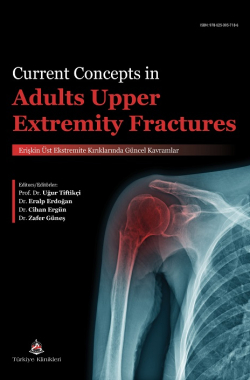IMAGING AND DIAGNOSTIC TESTS FOR FOREARM FRACTURES
Yasin Erdoğan
Ankara Etlik City Hospital, Department of Orthopedics and Traumatology, Ankara, Türkiye
Erdoğan Y. Imaging and Diagnostic Tests for Forearm Fractures. In: Tiftikçi U, Erdoğan E, Ergün C, Güneş Z, editors. Current Concepts in Adults Upper Extremity Fractures. 1st ed. Ankara: Türkiye Klinikleri; 2025. p.233-236.
ABSTRACT
Forearm fractures in adults are not the most common fractures of the upper extremities, but they are common fractures in isolated injuries and polytrauma. Patients present to the emergency room with pain, swelling and deformity of the forearm. Although the risk increases with high-energy injuries, close monitoring of the patient for compartment syndrome is important. A holistic examination that encompasses the entire body of a trauma patient is important to avoid missing additional injuries. Radiographic assessment of the patient should initially include anteroposterior and lateral radiographs. To avoid missing associated injuries, the patient’s elbow and wrist radiographs should also be assessed. In patients where this appears necessary, advanced imaging using computed tomography and magnetic resonance imaging can be performed.
Keywords: Adult; Forearm fracture; Computed tomography; Magnetic rezonance; Ultrasonography
Kaynak Göster
Referanslar
- Flynn H, Solarz MK, Rehman S. Forearm Fractures: Diagnosis and Contemporary Treatment Strategies. Instr Course Lect. 2022;71:303-12.
- Schulte LM, Meals CG, Neviaser RJ. Management of adult diaphyseal both-bone forearm fractures. J Am Acad Orthop Surg. 2014;22(7):437-46. [Crossref] [PubMed]
- Kalyani BS, Fisher BE, Roberts CS, Giannoudis PV. Compartment syndrome of the forearm: a systematic review. J Hand Surg Am. 2011;36(3):535-43. [Crossref] [PubMed]
- O'Brien AJ, Moussa MA. Using ultrasound to diagnose long bone fractures. JAAPA. 2020;33(2):33-7. [Crossref] [PubMed]
- Conlan TK, Beebe MJ, Weinlein JC. New Imaging, Diagnostic, and Assessment Techniques in Orthopedic Trauma. Orthop Clin North Am. 2019;50(1):47-56. [Crossref] [PubMed]
- Means K GT. Disorders of the forearm axis. In: Wolfe S HR, Pederson W, Kozin S, editor. Green's Operative Hand Surgery. 6 ed. Philadelphia: Elsevier; 2010. p. 837-68. [Crossref]
- Meglic U, Szakacs N, Menozzi M, Barco R, Alentorn-Geli E, Colozza A. Role of the interosseous membrane in post-traumatic forearm instability: instructional review. Int Orthop. 2021;45(10):2619-33. [Crossref] [PubMed]
- Rodriguez-Martin J, Pretell-Mazzini J. The role of ultrasound and magnetic resonance imaging in the evaluation of the forearm interosseous membrane. A review. Skeletal Radiol. 2011;40(12):1515-22. [Crossref] [PubMed]

